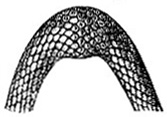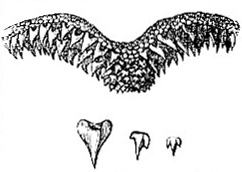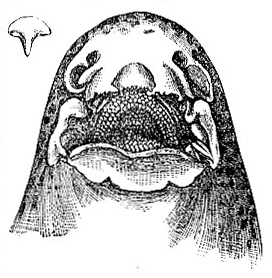The Hounds proper (Mustelus) possess a very different dentition, the teeth being small, obtuse, numerous arranged in several rows like pavement (fig. 2).

Fig. 2 -- Teeth of Mustelus
Five or six species are known from the shores of the various temperate and subtropical seas, one (M. vulgaris) being common on the coasts of Great Britain and the United States on the Pacific as well as the Atlantic side. It is of a uniform grey colour or sparingly spotted with white, and attains to a length of 3 or 4 feet. The young, about twelve in number, are brought forth alive in November. It is a comparatively harmless fish, which feeds on shells, crustaceans, and decomposing animal substances.
Of the Dog-Fishes proper (Scyllium, Chiloscyllium, &c.) some twenty species are known, which are spread over nearly all the temperate and tropical seas.

Fig. 3 -- Teeth of Scyllium canicula
Their teeth are small, in several series, with a longer pointed cusp in the middle, and generally one or two smaller ones on each side (figs. 3 and 5). They are all oviparous, their oblong egg-shells being produced at each corner into a long thread by which the egg is fastened to some fixed object. Some of the tropical species are ornamented with a pretty pattern of coloration.

Fig. 4 -- Chiloscyllium trispeculare
The two British species, the Lesser and the Larger Spotted Dog-Fish (Sc. canicula and Sc. catulus), belong to the most common fishes of the coast, and are often confounded with each other. But the former is finely dotted with brown above, the latter having the same parts covered with larger rounded brown spots, some of which are nearly as large as the eye. As regards size, the latter exceeds somewhat the other species, attaining to a length of 4 feet.

Fig. 5 -- Confluent Nasal and Buccal Cavities in the Chiloscyllium trispeculare
Dogfishes may become extremely troublesome by the large numbers in which they congregate at fishing stations; nor do they compensate for the injury they cause to fishermen, being but rarely used as food, except at certain seasons by the poorer classes of the Mediterranean countries, in China and Japan, and in the Orkneys, where they are dried for home consumption. The Black-mouthed Dog-Fish (Pristiurus melanostomus) is another European species which is rarely caught on the British coasts, and is recognized by a series of small, flat spines with which each side of the upper edge of the caudal fin is armed.
The Tiger-Shark (Stegostoma tigrinum) is one of the commonest and handsomest sharks in the Indian Ocean. The ground colours is a brownish-yellow, and the whole fish is ornamented with black or brown transverse bands of rounded spots. It is a littoral species, but adult specimens, which are from 10 to 15 feet long, are not rarely met far from land. It is easily recognized by its enormously long bladelike tail, which is half as long as the whole fish. The teeth are small, trilobed, in many series. The fourth and fifth gill-openings are close together.
Read the rest of this article:
"Shark" Article - Table of Contents



